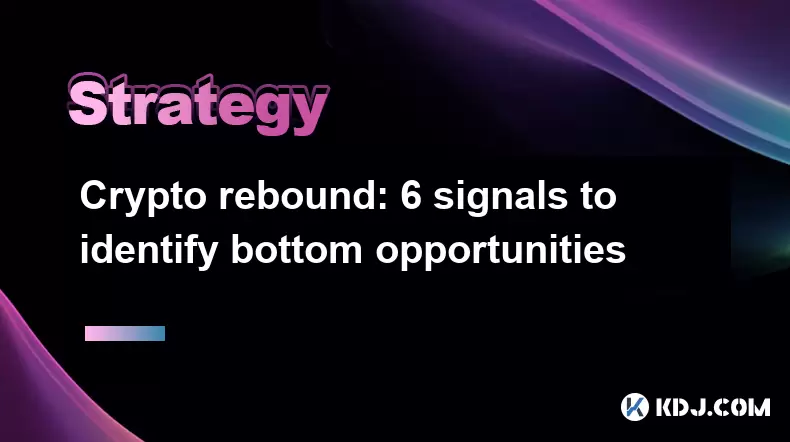-
 bitcoin
bitcoin $122025.899241 USD
-2.12% -
 ethereum
ethereum $4488.068729 USD
-4.11% -
 bnb
bnb $1315.348019 USD
8.65% -
 tether
tether $1.000457 USD
0.03% -
 xrp
xrp $2.875326 USD
-3.69% -
 solana
solana $222.043604 USD
-4.07% -
 usd-coin
usd-coin $0.999682 USD
0.00% -
 dogecoin
dogecoin $0.249887 USD
-5.62% -
 tron
tron $0.337379 USD
-2.59% -
 cardano
cardano $0.827763 USD
-5.06% -
 hyperliquid
hyperliquid $45.774531 USD
-2.43% -
 chainlink
chainlink $22.079309 USD
-5.87% -
 ethena-usde
ethena-usde $1.000156 USD
0.02% -
 sui
sui $3.482566 USD
-3.57% -
 stellar
stellar $0.386982 USD
-4.92%
Crypto rebound: 6 signals to identify bottom opportunities
To identify crypto market bottoms, watch for negative sentiment, low trading volumes, oversold technical indicators, decreased on-chain metrics, market cycle patterns, and increased institutional investments.
May 25, 2025 at 11:35 am

The cryptocurrency market is known for its volatility, with prices fluctuating dramatically over short periods. For investors, identifying the bottom of these cycles can be crucial for maximizing returns. A 'rebound' in the crypto market refers to a period where prices start to recover after a significant decline. Recognizing the signs that indicate a potential bottom can help investors make informed decisions. In this article, we will explore six key signals that can help identify bottom opportunities in the crypto market.
Market Sentiment
Market sentiment plays a crucial role in determining the direction of cryptocurrency prices. When the market is at its bottom, sentiment is often overwhelmingly negative. Investors may feel despair and fear, leading to a sell-off that pushes prices even lower. However, this negative sentiment can serve as a signal that a bottom is near.
To gauge market sentiment, investors can monitor social media platforms, forums, and news outlets for discussions about cryptocurrencies. Tools like the Fear and Greed Index can also provide a quantifiable measure of market sentiment. When the index indicates extreme fear, it might suggest that the market is nearing its bottom. Additionally, an increase in negative news and a decrease in positive news can be a sign that the market sentiment is at its lowest point.
Volume Analysis
Volume analysis is another important signal to consider when identifying bottom opportunities. During a market downturn, trading volumes tend to decrease as investors become more cautious. However, a sudden increase in volume can indicate that the market is reaching its bottom and that a rebound may be imminent.
To analyze volume, investors can use trading platforms that provide historical volume data for specific cryptocurrencies. A significant spike in trading volume, especially if accompanied by a slight increase in price, can be a strong indicator that the market is bottoming out. Additionally, looking at the volume of specific cryptocurrencies can provide insights into which assets might rebound first.
Technical Indicators
Technical indicators are tools used by traders to analyze market trends and make predictions about future price movements. Several technical indicators can help identify potential bottoms in the crypto market.
- Relative Strength Index (RSI): The RSI measures the speed and change of price movements. An RSI value below 30 typically indicates that an asset is oversold and may be nearing a bottom.
- Moving Averages: When the price of a cryptocurrency falls below its moving averages (such as the 50-day or 200-day moving average), it can signal a potential bottom. A subsequent crossover above these moving averages can indicate the start of a rebound.
- Bollinger Bands: These bands can help identify periods of low volatility, which often occur at market bottoms. When the bands narrow and the price touches the lower band, it can be a sign that a bottom is near.
On-Chain Metrics
On-chain metrics provide valuable insights into the behavior of cryptocurrency users and can help identify bottom opportunities. These metrics include data such as transaction volumes, active addresses, and network growth.
- Transaction Volume: A decrease in transaction volume can indicate that the market is at its bottom. Conversely, an increase in transaction volume can signal the start of a rebound.
- Active Addresses: A low number of active addresses can suggest that the market is at its bottom. An increase in active addresses can indicate growing interest and a potential rebound.
- Network Growth: A decline in network growth can be a sign that the market is bottoming out. A subsequent increase in network growth can signal the start of a recovery.
To access on-chain metrics, investors can use platforms like Glassnode or CryptoQuant, which provide detailed data on various cryptocurrencies.
Market Cycles
Understanding market cycles is essential for identifying bottom opportunities in the crypto market. Cryptocurrencies often follow a pattern of boom and bust, with periods of rapid growth followed by sharp declines. Recognizing where the market is in its cycle can help investors anticipate bottoms.
Historical data can provide insights into the length and severity of past market cycles. For example, analyzing previous bull and bear markets can help investors identify patterns that may indicate a bottom. Additionally, comparing the current market cycle to past cycles can provide context for understanding the potential timing of a rebound.
Institutional Involvement
Institutional involvement can also signal the bottom of the crypto market. When institutions start to invest in cryptocurrencies, it can indicate that they believe the market is at or near its bottom. Institutional investors often have more resources and information than retail investors, so their actions can provide valuable signals.
To monitor institutional involvement, investors can track news about institutional investments in cryptocurrencies. Platforms like CoinShares provide weekly reports on institutional investments in digital assets. An increase in institutional investments can be a strong indicator that the market is bottoming out.
Frequently Asked Questions
Q: How long does it typically take for a crypto market to rebound after reaching a bottom?A: The duration of a rebound can vary significantly depending on various factors, including the severity of the previous downturn, market sentiment, and external economic conditions. Historically, rebounds can take anywhere from a few weeks to several months.
Q: Can bottom opportunities be identified in specific cryptocurrencies, or is it more applicable to the overall market?A: Bottom opportunities can be identified in both specific cryptocurrencies and the overall market. While some cryptocurrencies may reach their bottom before others, analyzing the overall market sentiment and technical indicators can provide insights into broader market trends.
Q: Are there any risks associated with trying to identify and invest in bottom opportunities?A: Yes, there are risks associated with trying to identify and invest in bottom opportunities. The crypto market is highly volatile, and attempting to time the market can lead to significant losses. Additionally, false signals and unexpected market events can cause prices to move in unpredictable ways.
Q: How can investors protect themselves while trying to capitalize on bottom opportunities?A: Investors can protect themselves by diversifying their portfolios, setting stop-loss orders, and only investing money they can afford to lose. Additionally, staying informed about market trends and using a combination of the signals discussed in this article can help mitigate risks.
Disclaimer:info@kdj.com
The information provided is not trading advice. kdj.com does not assume any responsibility for any investments made based on the information provided in this article. Cryptocurrencies are highly volatile and it is highly recommended that you invest with caution after thorough research!
If you believe that the content used on this website infringes your copyright, please contact us immediately (info@kdj.com) and we will delete it promptly.
- BlockDAG, DOGE, HYPE Sponsorship: Crypto Trends Shaping 2025
- 2025-10-01 00:25:13
- Deutsche Börse and Circle: A StableCoin Adoption Powerhouse in Europe
- 2025-10-01 00:25:13
- BlockDAG's Presale Buzz: Is It the Crypto to Watch in October 2025?
- 2025-10-01 00:30:13
- Bitcoin, Crypto, and IQ: When Genius Meets Digital Gold?
- 2025-10-01 00:30:13
- Stablecoins, American Innovation, and Wallet Tokens: The Next Frontier
- 2025-10-01 00:35:12
- NBU, Coins, and Crypto in Ukraine: A New Yorker's Take
- 2025-10-01 00:45:14
Related knowledge

Practical parameter settings for a Bitcoin multi-timeframe moving average system
Sep 18,2025 at 10:54pm
Optimizing Timeframe Combinations for Bitcoin Trading1. Selecting appropriate timeframes is crucial when building a multi-timeframe moving average sys...

How can I filter out false breakouts in Dogecoin high-frequency trading?
Sep 22,2025 at 01:00am
Understanding False Breakouts in Dogecoin Trading1. A false breakout occurs when Dogecoin's price appears to move beyond a defined support or resistan...

Techniques for identifying tops and bottoms in the Bitcoin on-chain NVT model
Sep 20,2025 at 07:54pm
Understanding the NVT Model in Bitcoin Analysis1. The Network Value to Transactions (NVT) ratio is often described as the 'P/E ratio' of the cryptocur...

What does the surge in open interest in Bitcoincoin futures mean?
Sep 20,2025 at 11:18pm
Understanding the Surge in Dogecoin Futures Open Interest1. A surge in open interest within Dogecoin futures indicates a growing number of active cont...

How can I use the Ethereum USDT premium to gauge market sentiment?
Sep 18,2025 at 11:55pm
Understanding the Ethereum USDT Premium1. The Ethereum USDT premium refers to the price difference between USDT (Tether) traded on Ethereum-based plat...

What should I do if Ethereum staking yields decline?
Sep 20,2025 at 06:18am
Understanding the Causes Behind Declining Ethereum Staking Yields1. The Ethereum network transitioned to a proof-of-stake consensus mechanism with the...

Practical parameter settings for a Bitcoin multi-timeframe moving average system
Sep 18,2025 at 10:54pm
Optimizing Timeframe Combinations for Bitcoin Trading1. Selecting appropriate timeframes is crucial when building a multi-timeframe moving average sys...

How can I filter out false breakouts in Dogecoin high-frequency trading?
Sep 22,2025 at 01:00am
Understanding False Breakouts in Dogecoin Trading1. A false breakout occurs when Dogecoin's price appears to move beyond a defined support or resistan...

Techniques for identifying tops and bottoms in the Bitcoin on-chain NVT model
Sep 20,2025 at 07:54pm
Understanding the NVT Model in Bitcoin Analysis1. The Network Value to Transactions (NVT) ratio is often described as the 'P/E ratio' of the cryptocur...

What does the surge in open interest in Bitcoincoin futures mean?
Sep 20,2025 at 11:18pm
Understanding the Surge in Dogecoin Futures Open Interest1. A surge in open interest within Dogecoin futures indicates a growing number of active cont...

How can I use the Ethereum USDT premium to gauge market sentiment?
Sep 18,2025 at 11:55pm
Understanding the Ethereum USDT Premium1. The Ethereum USDT premium refers to the price difference between USDT (Tether) traded on Ethereum-based plat...

What should I do if Ethereum staking yields decline?
Sep 20,2025 at 06:18am
Understanding the Causes Behind Declining Ethereum Staking Yields1. The Ethereum network transitioned to a proof-of-stake consensus mechanism with the...
See all articles










































































